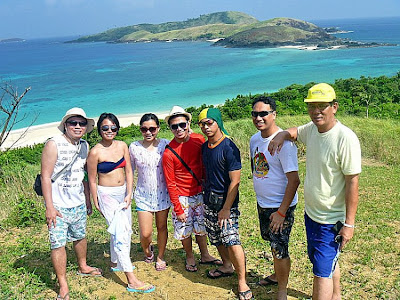 |
| Learning the basics from BUSA president Ryan Vito |
We were now on our last day in Daet and, after covering the 4th Bagasbas Summer Surf Festival, we took time out to learn surfing ourselves. It would be my second time to try (and failing miserably on 10 tries) and a first for Mark. Joining us at the surfing clinic was ABC TV5 correspondent Justine Santos, also a second time surfing student. Mr. Ryan Francis V. Vito, president of the Bagasbas United Surfers Association (BUSA), was on hand to personally teach us the basics of surfing.
First, we were taught the parts of the surfboard. Then, with the surfboard on the sand, Ryan taught us how to lie down on a surfboard (centered along the stringer), with the toes of our feet touching the tail-end (called the tail block) and making sure that the board is not tilting left or right while we’re trying it. Next, we were taught to push up on the board, with our hands on the sides (called the “rails”) of the board, then when up, to drag one foot up under us in the center of the board and, finally, to push up on our front foot into a standing position, using our arms like legs to push it up. Sounds easy. Well, it was easier said than done.
 |
| Dennis Suing trying to learn the proper stance |
Ryan assigned an instructor for each of us. Champion surfer Ms. Lolita “Mocha” F. Edusma was assigned to Jasmine while Mr. Joemel Bermejo, Mr. Rolan “Nash” Raro and Mr. Salvador “Onyo” Oclares were assigned to us guys. BUSA’s instructors were the first in Philippines to be trained by the Academy of Surfing Instructors. We headed down the beach, away from any surfers, our surfboards harnessed to our ankles. After walking some distance from the shore, I slowly mounted my surfboard with my instructor on the lookout for whitewater, waves that are crested and broken and rolling in long even white lines toward the beach. With the approach of whitewater, I was told to get ready and whoosh!!!, the whitewater slowly catches my board and lifts it up as I struggle to stand up and keep my balance while doing so. Try as I did, I failed to do so with each try, falling each time just as I was getting my footing, getting a face full of salt water every time. I finally gave up when the board hit and sprained my wrist.
 |
| Mark Nunez with his instructor Onyo Oclares |
I gladly surrendered my board and my instructor to ABC TV5 cameraman Mr. Amor Casiano while the other cameraman Mr. Dencio “Dennis” Suing filmed on. Then, it was Dennis’ turn to try it with Amor manning the camera. In both cases, as in my case, the waves won with every try, with wipe outs the rule and not the exception. The same was true with Mark and Jasmine. Well, better luck next time. Just, the same it was an experience we would gladly like to try again and again. Hopefully, there will be a next time. The waves of Daet haven’t seen the last of us.




































